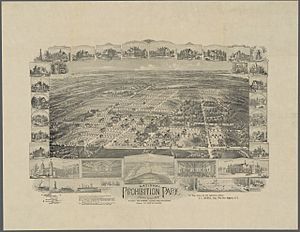Prohibition Park facts for kids
Quick facts for kids
Prohibition Park
|
|
|---|---|
|
Temperance town
|
|

1890s map of National Prohibition Park
|
|
| Country | United States |
| State | New York |
| City | New York City |
| Borough | Staten Island |
| Founded | 1887 |
| Opened | July 4, 1888 |
| Ceased | 1907 |
| Named for | Prohibition Party |
Prohibition Park, also called National Prohibition Park, was a special community and park on Staten Island, a borough of New York City. It was created as a place where people lived and visited without alcohol. This "temperance town" was founded in 1887 by people from the Prohibition Party. They believed alcohol caused many problems.
The park was meant to be a summer getaway. It grew to nearly 150 acres at its largest. However, it started to decline in the early 1900s. The land was eventually sold, and the remaining park areas became part of New York City parks in 1907. Today, these areas are known as Westerleigh Park and Northerleigh Park.
Contents
How Prohibition Park Started
The land where Prohibition Park was built used to be part of a large estate. This estate belonged to Thomas Dongan, a governor of New York long ago. In 1887, a group of people from the Prohibition Party bought some of this land. They were led by Christopher S. Williams and William H. Boole, a pastor.
They wanted to create a quiet summer retreat. This was because they believed alcohol caused a lot of crime and issues in the city. The park officially opened on July 4, 1888. It was managed by the National Prohibition Campground Association. In its first year, about 60,000 people visited the park.
What Was in the Park?
Prohibition Park had many fun things to do. There were areas for camping, picnics, and sports. You could play tennis or baseball. There were also horse stables. Visitors often stayed in tents set up on wooden platforms.
Over time, more permanent buildings were added. These included a bowling alley and a large hotel called the Park Hotel. The park also had a big meeting hall called University Temple, which opened in 1891. It could hold 4,000 people. By 1897, the park was very popular, with 200,000 visitors each year.
The park hosted many events. These included rallies against alcohol, religious meetings, and educational talks. There were also Chautauqua events, which were popular gatherings with lectures and entertainment.
Getting Around the Park
Getting to Prohibition Park became easier in 1892. A trolley line was built on Jewett Avenue. This trolley connected the park to Port Richmond. From Port Richmond, people could take ferries or other trolleys to different parts of Staten Island and beyond.
From Park to Neighborhood
In 1892, Prohibition Park started to change. It began to become a permanent place for people to live. More than 1,000 building plots were created. Each plot had a rule that no alcohol could be made, sold, or used there.
Many single-family homes were built. They had different styles, like Victorian and Dutch designs. New streets were also built, named after important figures in the Prohibition movement. A private school, the Westerleigh Collegiate Association, opened in 1895. It taught students from kindergarten all the way to college.
Why the Park Changed
Over time, the park's popularity began to fade. The company that owned the park started selling land to people who were not part of the temperance movement. Also, two important buildings, the University Temple and the Westerleigh Collegiate school, were destroyed by fires in 1903.
These events led to the decline of Prohibition Park. The community was renamed Westerleigh. In 1907, New York City bought the remaining undeveloped parkland. This land is now part of the city's park system.
Notable People Who Lived There
- William H. Boole: He was one of the people who helped start Prohibition Park. He was also a park trustee.

